The sun is a beautiful and powerful source of light, energy and—for many of us—joy. But most of us have to contend with sunscreen when we spend time in the sun, and sunscreens are confusing for many people. We’re urged by most health authorities to use it regularly, yet there are conflicting reports on whether / how / how much / what kind we should be using.
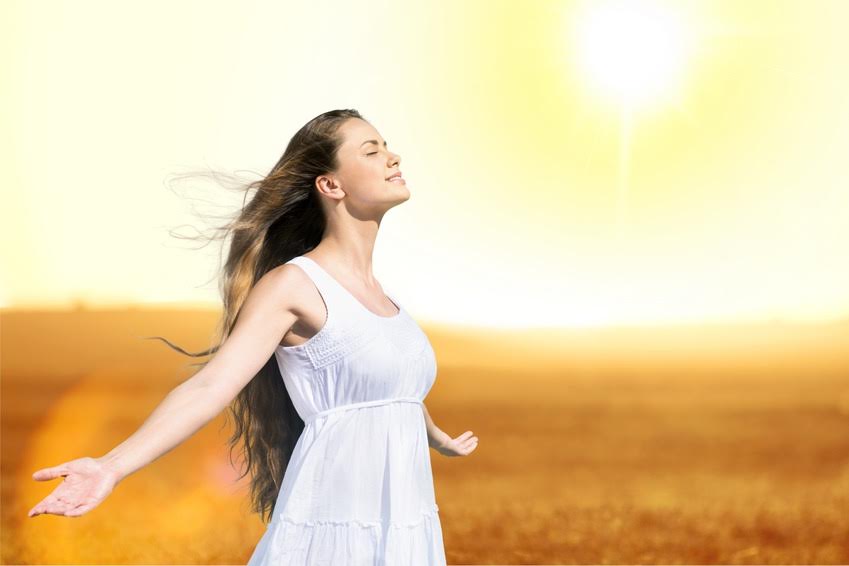
As a longtime natural skin and hair product enthusiast and aficionado—and ingredient watchdog—one of the most common questions I get (besides food/exercise- and herb/supplement-related queries!) relates to sunscreen. So, here, in the heart of another sweltering summer for most of the U.S., I’m sharing my favorites and some insights.
I’m a sunscreen “amateur expert” for several reasons. One is simply that I’m an avid and savvy label-reader on all products (something I love helping others become!). I’m always checking out the latest body-care stuff (I’ve been known to spend hours in what I call the “Center Aisle” of Whole Foods—that vortex of lotions and potions that seems to inexorably suck me into its magnetic field shortly after entering the store. Of course, it’s not actually always literally in the center of the store…but I digress).
The other reason for my “amateur expertise” is that I live in Arizona now, which means that I live in sunscreen. I actually used sunscreen zealously even when I lived in cloudy Seattle. I attribute my excellent skin with its remarkably few wrinkles (and the fact that people continue to regularly guess my age at a whopping 10-15 years younger than I am) in part to this. (Though I’m a tireless repeater of the fact that it’s never one thing—food, water, exercise, sleep, meditation, herbs, and other self-care practices also deserve credit—as does my dad for the nice olive complexion. Thanks, Dad!)
Whatever the case, what I’m doing is working pretty nicely. (More on my multi-faceted approach to beautifully maturing skin here.) I’m confident that insisting on purely natural skin-care products—including judicious sunscreen use—is part of that.
Before I go any further, it’s essential to mention a much larger and more comprehensive resource than this post for locating chemical-free or low-chem sunscreen. The Environmental Working Group (EWG) every year publishes an updated Guide to Safe Sunscreens. They don’t test every single natural sunscreen in the world (a few odd ones that I love have escaped their notice, just because they’re small-batch, under-the-radar brands). But their guide is insanely comprehensive all the same, and the amount of research and care that goes into it is tremendous.
They offer a full report, a special guide to Best Beach and Sport Sunscreens, a guide to Best Moisturizers with SPF, and lots of explanation for why it’s so important to. I don’t love every product they green-light, but a lot of that is personal preference related to texture. I do trust that the whole list represents the safest stuff out there.
The EWG is generally an awesome resource you should know about, and the Sunscreen Guide is one of their flagship efforts. You can read it online or download it. They also have excellent tips on sun safety.
You’ll find almost all of my own recs on their “good”/approved list (save for one that they have missed testing year after year, which I am sure based on the ingredients would get top marks if they got around to it).
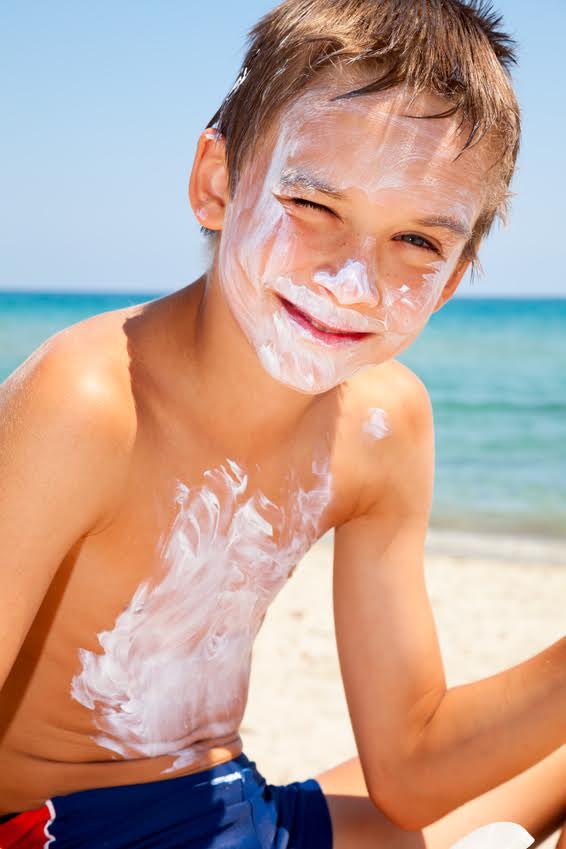
HOW WHITE IS IT?
Here’s what I can offer that EWG doesn’t, though. How does it look? how does it feel? how does it smell? EWG will tell you what’s in each product and whether any of the ingredients are suspect. They’ll tell you if there are hormone disruptors or suspected carcinogens or none of those. They’ll tell you if they consider it no/low/medium/high risk.
What they WON’T tell you is: does it smell like lavender and orange blossoms, or like Elmer’s glue? Does it go on silky and smooth, or sticky, gloppy, or streaky? Is it moisturizing or does it make your face feel like a sandy beach? Do you feel like you just used a lotion, or like you’ve been waxed? Or—often most vexatious of all with natural sunscreens—does it go on sheer and transparent, or thick and white, making you look like a member of the band Kiss? (Or worse still—like One That Shall Not Be Named that I just tried the other day—does it go on GRAY? Ack!)
MY guide is good for getting the scoop from a real human woman who actually uses this stuff day in and day out, and has tested nearly every natural product you can name—both natural-food-store brands and high-end boutique ones.
Therefore, if you want the meticulous data on the chemical breakdown of every ingredient, do go to EWG. But if you want to know if this one lasts in water, or that one sheds white crumbs all over your clothes, if this one smells like Fruit Loops or that one like nothing at all—I’m your gal.
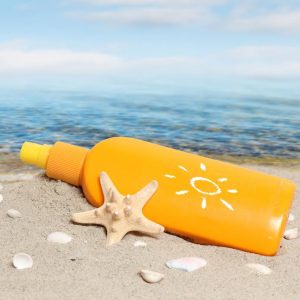
BEFORE WE TALK TEXTURE: BASIC SUNSCREEN SMARTS
Secondly, a little primer about some basic issues. The first really basic thing to understand is that sunscreen broadly falls into two categories—chemical screens and physical screens. This really makes things pretty easy. If you get this point, you can simply sweep a ginormous pile of products right off the table and never think about them again. (Don’t worry, there are still plenty left to choose from.) You can roundly dismiss a mass chunk of what comes on the market at a glance. Trust me—this makes life simpler.
The chemical screens block the suns UVA and UVB rays chemically. They absorb into the skin and work mainly by absorbing the sun’s rays. Chemical screens include these ingredients:
Aminobenzoic acid – carcinogen implicated in cardiovascular disease.
Avobenzone (butyl-methdiebenzoylmethane) – carcinogen
Cinoxate – evidence of skin toxicity
Dioxybenzone – strong evidence of skin toxicity and carcinogen; hormone disruptor and has been found in waterways, soil and air. Has been shown to have a “gender bender” effect in animals
Ecamsule – carcinogenic
Homosalate – endocrine disruption
Octinoxate — biochemical or cellular level changes, endocrine disruption, organ system toxicity
Octocrylene – found to be persistent and bioaccumulative in wildlife, liver issues and carcinogenic
Octymethocinnamate/Octyl methoxycinnamate – accumulates in the body, disrupts liver and is a carcinogen
Octyl salicylate – broad systemic effects in animals at moderate doses
Oxybenzone – carcinogen and contributor to vascular disease, may affect the brain and nervous system in animals
Padimate O – carcinogen
Phenylbenzimidazole – carcinogen
Sulisobenzone – strong evidence of skin toxicity, affects sense organs in animals
Chemical screens can be hormone disruptors and/or carcinogens. For more: http://www.ewg.org/sunscreen/report/the-trouble-with-sunscreen-chemicals/

Why do that, right?
Simply put, these suck. You don’t want ‘em. You don’t need ‘em, because physical screens offer a better way.
The mineral screens literally physically block the sun’s rays by sitting on your skin. Kind of like wearing a garment, almost. (Though clothes can do an even better job, and if you can stand it, it’s not a bad idea. I just don’t do well wearing long-sleeved shirts to hike or bike when it’s 97 degrees. But lately I’ve taken to wearing long-sleeved UPF-rated rashguards in the pool or ocean if it’s after 10 and before 4…)
Physical sunscreens generally use zinc oxide and/or titanium dioxide. While studies are mixed and you can find criticism of these ingredients (especially titanium dioxide), my unscientific conclusion after massive reading is that you are about ten jillion times better off with titanium dioxide on your skin than, say, octinoxate. (The EWG prefers zinc: “It is stable in sunlight and can provide greater protection from UVA rays than titanium oxide or any other sunscreen chemical approved in the U.S.”).
You also want to avoid nanoparticles (particles of matter micronized so small they actually can absorb into the skin and possibly enter the bloodstream; this seems more often done with titanium dioxide than zinc). Then you’ve sort of missed the point. Most screens nowadays specify if they don’t contain nanoparticles. (Not if they do. So if they say nothing, they may contain them.) I think the smart and good ones don’t use ‘em. EWG warns that many do, but I’ve been able to find good ones that at least claim they do not.
While at one time, nearly all titanium and zinc sunscreen products used to produce that ghostly pallor and feel like white paste, today’s crop includes many nice ones that don’t. You want the kinds that do this without nanoparticles. They do exist.

The Kicker: Mineral-based sunscreens can still contain other chemicals!
What’s trickier for most people who aren’t wise to the ways of marketing is that the physical blocks can STILL contain chemical ingredients—just not chemical screens. There are a ton—including a fat bunch of very expensive higher-end brands—that do this.
Petroleum derivatives, chemical preservatives, artificial colors and artificial fragrances are on the list. To name just a few common chemicals here: propylene glycol, BHT, methylchloisothizolinone, methylisothiazolinone, diazolidinyl urea, polyisobutene, PEG-7 trimethylolpropane, butylene glycol, iodopropynyl butylcarbamate, triethoxycaprylylsilane, methylparaben, ethylparaben, butylparaben, propylparaben, isobutylparaben, synthetic beeswax, hexylene glycol, trietholamine (TEA), DEA, MEA, isoparaffins, petrolatum, triclosan, quaternium-15, DMDM hydrantoin, behentrimonium chloride, phenoxyethanol, cyclopentasiloxane...
(One of my favorite brands, Drunk Elephant, also has a great “black-list” of skin care ingredients overall that you don’t want to use. It’s a very close match to my own “never buy anything with this s**t in it” list above. Highly recommended.)
I avoid these (in all my skin and hair products). Happily, you can too, and this is where my top picks come in.
Although labeling is inconsistent and unregulated in this regard, the truly natural products can and will say “ALL-natural”; the “fake-natural” ones will focus on the mineral SUNSCREEN ingredients, saying things like “physical UV blocker” or “physical UV defense” or “mineral sunscreen.” They will NOT be able to say “all-natural” or “no synthetic ingredients.” (While “all-natural” IS a totally meaningless term for food, not as meaningless with hair and skin. All-natural generally means none of the above ingredients.)
I’m not going to rag on a specific brand or product here, although there are plenty I could turn into a test case. The thing is, you’ll find many of them at the department store cosmetic counters, at places like Sephora and Dermstore and Ulta (though such places also carry some of the good ones) and even your dermatologist’s office, alas.
If you have a question about your favorite, write me and ask—I am happy to answer. Or comment below and start a conversation!
But all you really have to do is turn the bottle or tube over and read the ingredients. “ACTIVE INGREDIENTS” may say “titanium dioxide” and/or “zinc oxide.” But check out the “INACTIVE INGREDIENTS” list. If it’s full of the ingredients listed above, or a bunch of similar unpronounceables, skip it. You can go to the EWG guide and look up many of these ingredients, too.
But don’t we need vitamin D?
Third, let’s acknowledge that there is a fairly hot debate about whether we should be screening ourselves at all. Most dermatologists still insist that excessive sun exposure does increase cancer risk (not to mention wrinkles, age spots, and other unsightly signs of skin aging). Other health sources, however, contend that when we block our skin completely from sunlight, we’re causing or contributing to other health issues.
And I agree with both—meaning balance is key.
The EWG notes that sunscreens aren’t terribly effective on the whole at protecting you from harmful UVA (skin damage/aging) and UVB (burning) rays anyway (especially the way most people use them—a thin smear or lame swipe won’t do it; you have to cover yourself thoroughly and systematically—so most people still get sun exposure even when they do wear sunscreen).

As usual, I think the answer is somewhere in the middle. We don’t want to bake and fry our skin constantly (even if there were no cancer risk, cultural vanity dictates that we don’t want the “leather and liver spot” look). Neither do we want to eschew sun so completely that we lower the levels of Vitamin D in our bodies, and lose all the other physical and mental health benefits of exposure to natural light.
If you can get 15-20 minutes of sun exposure three or four times a week, that’s reportedly all it takes to maintain healthy D levels. The rest of the time, you should be at least screening if not blocking, because that’s how the evidence is stacked. You do not need to fry at midday all week long to get your D, and the evidence is pretty overwhelming that if you do, your skin will age faster in ways our culture doesn’t find pretty—and you may increase your cancer risk as well.
(You can get your D levels checked with a blood test—that will settle the debate for your own self. The D from sunshine is considered healthier and more bioavailable, but D3 supps will do the trick in a pinch, especially if you live in a place where there just isn’t a whole lot of sun year-round. When I lived in Seattle, my D levels were abysmally low; even after years in Arizona, mine are low-normal because I wear good sunscreen, and wear it pretty well, just about 365 days a year. So I do supplement.)
I also practice basic sun sense. I do outdoor activities before 11 a.m. and after 4 p.m. during late spring, summer and early fall; in winter, I shoot for midday to get more healthy light. I do let my skin go bare for short periods a few days a week (e.g., 15 minutes watering plants or letting the dog out before I slather on the screen). I use higher SPFs (30-50) in summer, and for extended sunny-day outings like long hikes or bikes rides. I allow myself lower-SPF products in later fall, winter, early spring (SPF 15-20) to let in a little more light. But I use it well: I use a LOT, and I reapply.
The functional-medicine doc Dr. Mark Hyman also offers this excellent sun safety post on his blog, which especially covers Vitamin D issues well (with a leaning toward less sunscreen as well as supplementation). I recommend it.
SPEAKING OF SPF…
Hoo boy. I just opened another can of…sunspray. For now, let’s just say that we know SPF factors tend to test as less potent than they claim, partly due to product variables and partly do to user error (not applying enough, often enough). Most everyone should be using SPF 30 most of the year in my opinion, especially in Southern/sunny climes. I use a facial SPF 15 only in the dead of winter or when I’m venturing outside for the first time after 5 p.m. Based on studies about products and user error, chances are you’re getting less coverage than you think.

But how does it work? This is still a hugely misunderstood math-y sort of problem. There are detailed explanations all over the web; I think Badger does a particularly nice, no-nonsense job of explaining it. This one’s good too, geared at kids.
Remember too that SPF only refers to protection against UVB rays (a “broad-spectrum” sunscreen will screen UVA as well, and the minerals ones do too. But SPF doesn’t refer to that aspect).
“Okay, okay, I get it! Now what about those favorites?”
With all that out of the way, let’s get down to the recommendations I can offer that will let you enjoy the rest of the summer (and if you’re really smart, fall and winter too!) protected and comfortable—without feeling white or waxed, and without noxious chems on your skin.
I’ve tried dozens and dozens of natural sunscreens looking for perfection in look, feel, and performance. My favorite brands personally tend to feel more like moisturizers, aren’t too white, and don’t make me feel siliconed, sticky, or greasy.
MY CURRENT TOP-SHELF SUNSCREEN LINEUP
(updates for 2019!)
I have a few new sunscreen likes/loves for 2019!

A new rec with some reservations…
Australian Gold’s Botanical Line is phthalate-free, but the scented ones from my natural-nose point of view could still knock you over (and are synthetic even if free of the worst chems supposedly) so I recommend ONLY the SPF 50 kids unscented. For me, this one has given a bit of competition to the Thinksport (see below) that holds top-shelf status for me as a body screen. (I still mix the Thinksport with one of my tinted SPF 30s for face, always).
The AG is a light, sheer, silky, almost powdery textured cream that goes on smooth and the white disappears…and it stays on. (You have to really scrub it off—and if you layer it, it can start to sort of get “crumbs” when you rub it off later.) I like that it’s not the slightest bit greasy. (If you have super dry skin, you might not like the “powdery” feel.) And it really works—in and out of the water. I’m using it a lot and not burning at all.
I should note that I really don’t love this company because they make an entire, massive NON-botanical line—including for kids!— that DOES have phthalates (they’re so proud of their “phthalate free line” and yet continue to sell all their other stuff, so what does that say? WTF?) So watch out for that—I am NOT uniformly recommending the brand. Also, I don’t like the phenoxyethanol in this, and EWG dinged them hard for that, even in this product which is otherwise free of nasties. I’m still preferring the Thinksport for that reason, but I do love the texture of this reasonably safe unscented product.
I’ve linked the company above, but note you can get it cheaper from Ulta Beauty, Vitacost, Target and Amazon (etc) than from the company. I stock up when Vitacost has sales, which they always do in some way or another.

Colorscience:
Tint Du Soleil Mineral Foundation and Whipped Mineral Sunscreen, plus Brush-On Sunscreen SPF 50.
Even though dermatologists alas often sell chemical crap that’s just higher priced (eg Elta MD), mine doesn’t and I discovered this brand there! As a tinted screen, this has all but replaced the MD Solar Tinted SPF 30 I’ve long listed below. (That one still offers a little more “slip” and silicone-y staying power if I’m going to be in water or sweating heavily, so I still keep one in the swim bag).
Colorescience has good ingredients and a wonderful texture and feel. Not too dry, not greasy, smooth. And the brush-on powder has replaced my Mineral Fusion Brush-On because: it’s SPF 50 not 30, and the brush is WAY softer and nicer, not leaving little black strands all over my face. (NOTE: Brush-on powder should NOT replace regular liquid or cream screen; it’s more of a mattifying, smoothing layer of extra protection.)
Colorescience is a little pricy but you can find good deal on eBay, especially if you’re willing to buy something nearing expiration date (I don’t recommend going too far out, but if you use the stuff up fast like I do (and I recommend you DO use it up fast because you need a lot for true protection!)
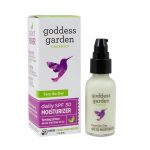
Goddess Garden Face The Day Moisturizer and Primer SPF 30
This one surprised me! Goddess Garden regular sunscreens in the tubes never made my list because, although the company is great and their ingredients are utterly beyond reproach, I could not deal with the “thick white” scene.
However, I received a sample of this product and fell so in love with it I had to buy it. It’s light, totally non-white, not shiny, and works great as a daily moisturizer when I’m not going to be doing any major outdoors stuff (I’m not sure I would put it up to heavy hiking or swimming). It’s a perfect work day/under makeup kind of lotion. Again, linked the company above, but other retailers will offer a better deal usually.
Ingredients I especially like: skin-loving essential oils like helichrysum italicum and wild carrot seed, plus butterfly bush extract.

Thinksport SPF 50
Thinksport 50 is, three years after the original publication of this post, still my top all-around face AND body choice for sweaty sports and swimming. The “desert island” choice. 🙂 If I had to take one sunscreen with me on a trip, it would be this one. It’s not too white, not too sticky, not too thin or thick, not too dry, not too oily…just right.
In the now four years I’ve been publishing this post (!), they’ve come out with many lines of nice body care stuff, too. You can get their screen lots of places (including REI, Whole Foods and tons of natural product stores); just Google it. It does contain dimethicone, a silicone, but I don’t really feel it, and ingredients are otherwise short and sweet.
This one’s all zinc oxide (for active mineral ingredients), so also a good choice if you choose to avoid titanium dioxide. Non-nano.
The kids’ version in the blue-yellow packaging is exactly the same except for a different fragrance (per the company: “The formulas are the same. However, we use papaya in the kids and currant in the adult version”). And I often use the kids’ just because it’s a prettier tube on the counter. 🙂 (Yep, weirdo! I like to get mine at Vitacost—and nope, no affiliate fees for me for saying so, Vitacost doesn’t do that, wish they did!)
Ingredients I especially like: jojoba oil, tocopherols (vitamin e), olive oil, raspberry seed oil, cranberry seed oil, hyaluronic acid (made from vegetable), papaya.
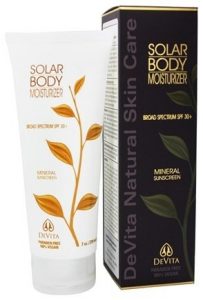
Devita Solar Body Moisturizer SPF 30
Devita also makes an SPF Solar Protective Moisturizer for the face and it’s quite good too—similar in texture and weight to the Babo for face, perhaps a bit whiter. But the body one fills a harder-to-fill void, and has returned to become my go-to SPF body moisturizer since Live Live discontinued their miraculous lotion (::sniff::!). A bit white at first, but not thick and disappears quickly. One friend says this is her little daughter’s favorite.
In days when I don’t need the heavy-duty, sweat-proof, high-SPF coverage of the Thinksport (say, a walk outside as opposed to hike or bike; more dress-up than sporty) this is my current fave. I feel like I’m doing my skin a lot of good when I use it. They don’t skimp on serious bioactive quality botanical and active ingredients—high-end yet not insanely priced. A company with integrity and I like that they’re made in my home state as well!
One note—this one does not last as long from season to season; it tends to separate and get little white chunky flecks in it, so buy fresh and use it up.
Ingredients I especially like: gotu kola, rose hip seed oil, aloe, green tea shea butter, Irish moss, grape seed extract, chamomile oil, seaweed extract, hyaluronic acid, shea, butter, seaweed extract, copper gluconate.
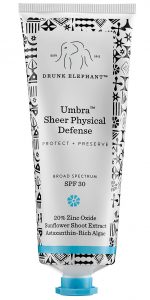
Drunk Elephant Umbra™ Sheer Physical Daily Defense SPF 30
This one wins lots of natural beauty awards from high-end wellness blogs, and when I finally tried it, I could see why (and added it here immediately!). It’s a really sheer, light (but not too light), not-too-white, moisturizing-but-not-sticky lotion-y cream. It’s not just a sunscreen; it’s a bona-fide anti-aging beauty product. It’s also a truly natural brand with a fun, smart vibe (their website and packaging is cool too). And as mentioned earlier, they really advocate and explain why it’s vital to avoid certain ingredients.
It’s not cheap, and for families who want hardworking basics, Thinksport may be a better bet. But if you want a bioactive day cream that offers serious protection and that’s robust enough for body—and you’re a sucker for something that looks pretty on the counter or in the purse—I recommend this one. Two other notable advantages over Thinksport that may make you shell out the extra dough: no silicones (a rare feat! and still smooth!) and totally free of fragrance and essential oils for ultra-sensitive types.
This one’s 20% zinc oxide (for active mineral ingredients), so also a good choice if you choose to avoid titanium dioxide. Non-nano.
Ingredients I especially like: astaxanthin, grape juice extract, sunflower shoot extract, marula oil.
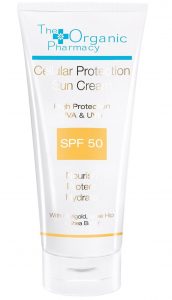
Organic Pharmacy Cellular Protection Sun Cream SPF 50
When I first saw the price on this one I was like “Get outta town. This better be good.” I was highly skeptical because there are a lot of high-priced skin-care products—more in the conventional but some in the natural cosmetic world too—that just aren’t worth the price. The truth is, you can get a perfectly serviceable, fine-quality all-natural mineral screen much cheaper than this.
But if you like luxury—and I don’t mean the kind of department-store manufactured luxury that’s actually the exact same chemical garbage as drugstore brands (only packaged/marketed slicker—then this is worth it. Thoroughly light and sheer, and bioactive anti-aging ingredients that help with hyperpigmentation. It doesn’t just screen, it improves your skin. I will still only buy it when I can find it way discounted, but I had to try it for you (heh heh, excuses excuses). I use it sparingly, face only, but on a day when I want a high SPF in a light, sheer cream (non-swim/workout) that just feels amazing, this is the one.
Uses both titanium and zinc oxide as screens.
In the end, though, the Thinksport 50 + Md Solar Tinted Creme SPF 30, blended, make a more affordable day-cream option for me.
Ingredients I especially like: lactic acid, marigold extract, rose hip seed oil.
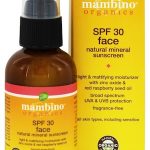
This one has actually replaced the Jose Maran (below) for me. It’s similar as a daily face lotion, but a little lighter and less tacky, simpler/fewer and more pure ingredients, and less pricey too. There’s also a larger, better-priced package for kids/body in a vacuum pump.
Ingredients I especially like: raspberry seed oil, coconut oil, aloe, green tea extract, It’s a chopping 25% zinc oxide (no titnaium dioxide) without being white at all. A tad shiny/oily but a little mattifying lotion or powder fixes hat easily.
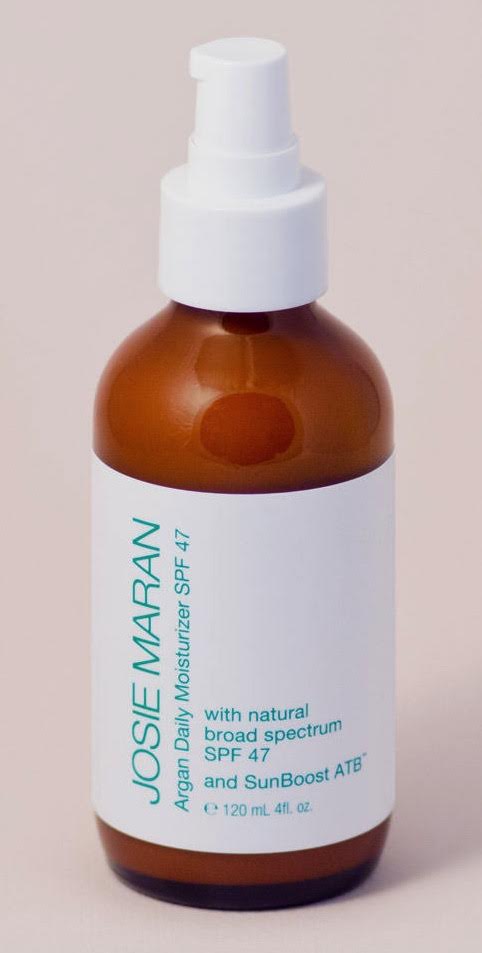
Josie Maran Argan Daily Moisturizer SPF 47
Not all of Josie Maran’s skin, hair and cosmetics meet my standards, alas (e.g. some cosmetics have synthetic colors and other ingredients, though it’s nice that a fashion model created a brand with at least some fully natural products. And she’s made argan oil almost a household word!). But this sunscreen does meet my standards, and I have had it in my lineup. It’s pricey—a luxury brand—so I tend to use it sparingly. I often mix it with a lighter, more slippery product (like the MD Solar Creme) as it tends to be a bit tacky. For face only.
This one’s a mix of titanium dioxide and zinc oxide.
Ingredients I specially like: argan oil, green tea, aloe, jojoba oil.
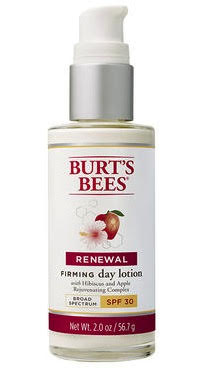
Burt’s Bees Firming Day Lotion SPF 30
This find surprised me. It’s a great lower-cost sunscreen that works both a regular moisturizer and sunscreen. I mix it with higher-SPF sunscreens sometimes, but on an average day, if I’m not out to do something super-sporty or extended, it’s the first one I reach for (it gives me a good base, and I can always add another layer later). I’m not always the biggest Burt’s Bees fan (like many budget drugstore/natural-food-store “natural” brands, the product line is a mix of pure and less-so products). But this one’s good. It does contain a few unpronounceables that worried me, but I looked them up in EWG’s database and all were rated low- or no-risk. If EWG isn’t concerned, I’m okay with it.
One thing I find super annoying about it is that although the glass bottle is nice (healthier than plastic), the last third or so of the product tends to be hard to get out via the pump and I end up having to shake it out or reach in with Q-tips to get at it. They should make a vacuum pump for it, I think.
This one’s a mix of titanium dioxide and zinc oxide (more zinc).
Ingredients I especially like: hibiscus flower, watermelon fruit extract.
Live Live & Organic SPF 30 SADLY, DISCONTINUED! 🙁This is hands-down my favorite body screen. I come back to it again and again, and always have it around. I love it because it is the most body-lotion type of sunscreen I have ever found. You wouldn’t even know it was a sunscreen. I honestly don’t know how they do it. (They say “micronized” zinc and titanium dioxide but state it is non-nano—I even wrote to them and asked.) But it works! Goes on like a silky lotion, zero white, and yet I don’t tan or burn when I wear it. It’s genuinely moisturizing too!
Oddly, the only place I can find it to buy is an online supplement warehouse called iHerb.com. I always keep two on hand in case they run out! At $18 for a large 7-ounce bottle (some of the others cost that much or more for 1.5 to 4 ounces!), I find it quite economical too.
Ingredients I especially like: MSM, organic apricot oil, organic almond oil, sweet orange oil, aloe, calendula extract, usnea extract, vitamin E, beta carotene (not retinyl palmitate!).
Coola Mineral Baby Organic SPF 50
Like many brands, Coola makes a large line that includes both all-natural/mineral/chem-free screens as well as those using chemical sunscreens. Their 50 sport uses chemical screens, but the 50 for baby is perfect. Many organic ingredients, and it’s a great choice for active use. It’s very cocoa-buttery, has that yummy cocoa butter smell, and it’s fairly white at first. It IS quite thick and greasy/waxy. This is def body-only for me. But when I want a natural sunscreen that will really stay on in swimming or super-high-sweat conditions, this is one of my top choices. (NOTE: It stays on so well, you really have to scrub to get it off. Fair warning.)
This one’s a mix of titanium dioxide and zinc oxide.
Ingredients I especially like: organic shea butter, coconut oil, cocoa seed butter, avocado oil.

MD Solar Sciences Mineral Crème SPF 50
This is the screen in my arsenal that I feel a tad queasy about, but I do keep it around because (a) EWG gives it an OK rating and (b) it’s so handy for certain things. It is a mineral block and does contain silicones, which is what gives it its smooth application and non-shiny, almost beauty-balm-like coverage without actual tint. It’s very mattifying, and a smidge really helps give my Thinksport or Maran a good bit of “slip,” great for face. It also stays on really well (the silicones mean water beads up and rolls off). I tend not to use it alone and not on the body, so one tube can last me a year.

I also like their tinted SPF 30 as well—mixed with the Thinksport it makes the absolute best tinted screen/face moisturizer! By blending I get a net SPF 40 which suits me most days for non-sports activities.
This one’s a mix of titanium dioxide and zinc oxide.
Ingredients I especially like: cranberry fruit extract, pomegranate extract, and green tea.
Babo Botanicals Daily Sheer SPF 40
Especially good for the face (at 1.7 ounces per tube, it’d be a bit pricey to cover your body with very often, though I like the size for my bike pack or purse), it really is sheer and lightweight. The white disappears quickly for such a decent SPF. It goes on just a bit tacky, but even that disappears fast. Doesn’t leave me shiny. It has a nice light essential oil fragrance, and some lovely ingredients. It provides me with a sort of in-between when a SPF 30 moisturizer just doesn’t feel like quite enough and the SPF 50s feel like overkill. Mixes well with a tiny dab of one of the tinted ones mentioned, too.
Ingredients I especially like: avocado oil, jojoba oil, shea butter, white tea leaf extract, rose flower extract, petitgrain oil, mandarin oil, pongamia pinnata seed oil.
Please note: where possible I tried to include the link to the actual maker/manufacturer website, just for neutrality. Obviously, you don’t need to buy direct from the manufacturers, and most often it’s cheaper to use another outlet. You can find most of these products in many places online and in stores. I get some of them at Whole Foods and some at my favorite online purveyors of natural products, such as Vitacost or LuckyVitamin. I even get some on eBay.
I am NOT affiliated with ANY of these products and do NOT receive any kind of compensation (even freebies!) for mentioning them. Everything written here represents my own free, untethered opinion.
WHERE TO BUY NATURAL SUNSCREENS AND OTHER NATURAL SKIN PRODUCTS
If you Google, you will find all of these products and can price-compare. But here are some natural skin-care boutiques online that sell all-natural sunscreens (and lots of other good stuff!):
- Detox Market www.thedetoxmarket.com
- Credo Beauty www.credobeauty.com
- Follain www.follain.com
- Alleia www.aillea.com
- Eco Diva Beauty www.ecodivabeauty.com
- Fig & Flower www.shopfigandflower.com
- Clean Beauty Mart www.cleanbeautymart.com
- The Green Life www.shopthegreenlife.com
- Truth Beauty Co. www.thetruthbeautycompany.com
- Ayla Beauty www.aylabeauty.com
- LoveLula www.lovelula.com
- Pharmaca www.pharmaca.com
- LeVert Beauty www.levertbeauty.com/
- Petit Vour www.petitvour.com
Whole Foods is always a good in-person place to find many of these products. They do carry products with chemical screens (I think they shouldn’t) but they also sell many excellent natural sunscreens, both budget and high-end.
Online herb and supplement “stores” like LuckyVitamin, Vitacost, Vitaminlife and iHerb are also good sources. Amazon carries pretty much everything, but they may or may not have the best price. Some of these products can even be found at Walgreens and such.
RUNNERS-UP: PAST FAVORITES
The above top-shelf picks replaced these for me, but I once loved these and I’d still use any of them in a pinch. In fact, leftovers still adorn drawers, guest bath, backpacks, swim bags…
Derma E Antioxidant Natural Sunscreen 30. Also one for face and one for body. I find them pretty identical. Very similar to Devita, perhaps less lotion-y, a little drier, a little less moisturizing but also the white disappears quickly and it stays on perhaps better than Devita.
Suntegrity SPF 45 for body. This used to be my go-to beach/pool screen before I found Thinksport. It stays on like crazy, but I find it hard to rub in. It smells divine. It’s quite pricey, and I believe the Thinksport works just as well. This was created by a woman whose mother died of skin cancer, and it’s a nice high-end product made with care. They have a face screen and tinted beauty balm as well.
Erbaviva SpF 15 and 30. Made for babies, lovely for adults too. I still keep one of these in my hike pack. A bit white, but very smooth, rubs in well. Smells deliciously of lavender—very soothing. Feels cool and calming. Stays on decently.
Mexitan. Very white, but very effective. Can become dry and crumbly over time. But I’ve used this in blazing, broiling sun and gotten hardly a hint of color on me. Dr. Mercola liked it so much, he branded this sunscreen himself (his screen is basically Mexitan with his name on it). Tropical Sands is the same deal—same product with different branding.
Aubrey Sun for Kids SPF 30. Be careful with Aubrey—like many natural-food-store brands, they make both chemical sunscreens and physical only. (This goes for Alba Botanica, Jason, Kiss My Face, etc., too.) I like the squirt bottle, the thinner consistency, and the beach-y smell, but it’s a bit white.
Mychelle Sun Shield 28 and Replenishing-Solar-Defense-SPF-30 They’re a bit dry, unspreadable and white for my tastes—and I say this as a Mychelle fan who uses literally six of their facial serums loyally and religiously. But I love the brand overall and I know people who really like their screens, so I include it here.

Badger Active Kids Broad-Spectrum SPF 30 Tangerine Vanilla. A bit whitish, but blends surprisingly well and quickly, and smells amazing. Mmmm. I keep this in the car for body touchups. Only six ingredients—very nice!
FAVORITE SUN STICKS
I keep sun sticks stashed in my hike packs, bike panniers, hydration packs, car for face and touchups. There are mountains of them, but the mineral ones are often very white, dry, and streaky, so I’ll put in my plug for MD Solar Sciences Natural Mineral Sunscreens Stick 40, and Mineral Fusion Natural Mineral SPF 30 Sun Stick. Also good: Mychelle’s Sun Shield Clear Sun Stick SPF 50.
TIP: Leave in hot car and these will melt. Leave in jacket pocket in hot car and jacket is ruined. Learn from my experience.
BEST SPF FACIAL MOISTURIZERS
If you want a true facial moisturizer lotion that offers substantial SPF protection without that white or grayish cast, besides the ones above on my top list, I recommend these brands:
- John Masters Organics
- Body Deli
- Jurlique
- Dr. Hauschka
- Kimberly Sayer
- Naturopathica
- Yes To Grapefruit
- Juice Beauty
- Annemarie Borlind
And last but not least, if you’re interested in beauty balms (BBs), or color correction creams (CCs), I’ve tried dozens of these too (natch!). Again, many are too thick, too silicone-y, too sticky, too streaky, or too ghostly. Here are the ones that make the cut for me.
- Andalou BB and CC, SPF 30. My top favorites for tinted screens these days—they are a tiny bit thicker and shiner than I’d like, but the tones blend really well and cover nicely. And it’s a solid brand that you can get at Whole Foods as well as online. They have a Color Correct CC, Age Defying BB, and Brightening BB—all with some lovely bioactive skin-treating ingredients. I like to mix the CC cream in “sheer tan” with the Thinksport 50 for my face, to get max screening and a nice glow.
- Devita BB Cream. Very nice texture with light coverage. But only SPF 15.
- Mineral Fusion Mineral Beauty Balm. Probably my favorite for appearance and texture, but only SPF 9, fairly useless for me except in winter. Comes in Illuminating, Perfecting, and Untinted.
- REN Skincare Satin Perfection BB Cream. This is a higher-end brand I LOVE. Their tinted moisturizer is so nice and light, but it’s only SPF 15. Great winter daily for me, or to mix in with heavier sunscreen for tint.
- Cotz for Face SPF 40. Pretty silicone-y, but very matte and nice even coverage.
THE FINAL WORD
IF you like their feel, I would also trust sunscreen products by Alba Botanica, Sia, TrueNatural, Episencial, Goddess Garden, Elemental Herbs, BurnOut, Beyond Coastal, Jurlique, Dr. Hauschka, The Body Deli, Blissoma, Caribbean Naturals, Pratima, Acure, Everyday Shea, and Babyganics…all of these range from health food store type brands to high-end natural luxury brands. There are many more, but a few off the top of my head.
I just found many of these too white, too thick, too sticky or tacky, too dry, or just not awesome for the price (or some combo of several of those). That’s why they didn’t make my list. But the ingredients are good, and EWG approves.
I always have a list of new ones I’ve never tried, and I’m tireless in my search for the most natural and enjoyable-to-use sunscreens! I constantly add here any great news ones I find.
Wondering about your brand? Want me to review one? Have one I hate that you love, or that I love but you loathe? 😉 I want to hear from you! Run it by me or add your comment below; let’s have a conversation! And please share this post with conscious consumers and other passionate productistas!
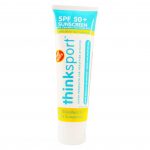
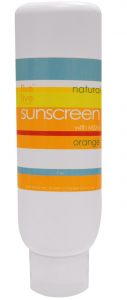
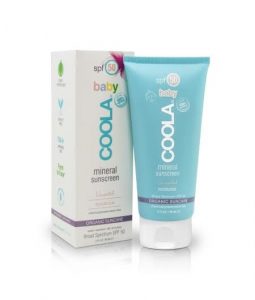
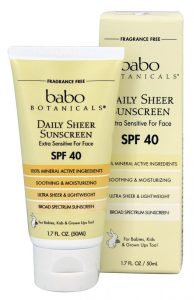
Perfect timing! The weather is heading back into the 90’s in Seattle and I’ve just lost faith in my standby, LaRoche Posay, which likely has a slew of the chemical blockers anyway and failed to prevent a burn.
Just ordered the Live Live brand and can’t wait to try it! Thanks for camping out in Whole Foods for us, trying this all out! 🙂 I love the new blog!
So glad you like the blog! I think you’ll really like the Live Live sunscreen. Let me know! Yes, I’ve checked into the brand you mention (what brand haven’t I checked? 😉 ) and was not happy with the ingredients. 🙂 If you compare the ingredients to the list I posted in the article, you’ll see what i mean. Sorry you got a burn!
I just tried the Live Live today (it got here FAST!) and you’re right, I love it! My issue with most sunscreen brands are a) the smell, whether it’s the fragrance added or that nasty metallic scent; b) the feel; or, c) my skin’s response, usually a horrible breakout. So far, this stuff is blowing me away. Fingers crossed for clear skin in the days to come! That’ll be the final test.
I’m so glad, Kristen! 🙂 Keep me posted! Robyn
It’s a shame you don’t have a donate button! I’d most
certainly donate to this excellent blog! I suppose for now i’ll settle for book-marking and adding
your RSS feed to my Google account. I look forward to new updates and will share this site with my Facebook
group. Chat soon!
Thank you! 🙂 Robyn
Hi, just wanted to tell you, I enjoyed this post. It was inspiring.Keep on posting!
Thank you, I will! Robyn
Hi! This post could not be written any better!
Reading through this post reminds me of my good old room mate!
He always kept talking about this. I will forward this
article to him. Pretty sure he will have a good read. Thanks for sharing!